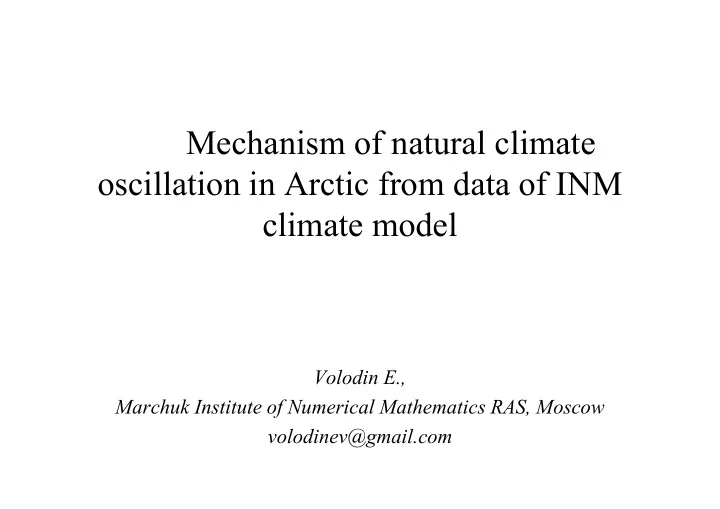

Mechanism of natural climate oscillation in Arctic from data of INM climate model Volodin E., Marchuk Institute of Numerical Mathematics RAS, Moscow volodinev@gmail.com
Time series of annual mean temperature in Angmagssalik (East Greenland). Oscillations with period of 60-70 years and 10-20 years can be seen
To study the mechanism of climate oscillation in Arctic, data of climate model INM-CM5 was used. Model has spatial resolution in atmospheric block 2x1.5 degrees in longitude and latitude, and 73 levels up to 0.2 hPa (60 km). In oceanic block, resolution is 0.5x0.25 degrees and 40 levels. Preindustrial run was performed with the model, where all forcings are fixed as in year 1850. Only natural climate variability can be seen in this run. Duration of run was 1200 model years. It takes about 6 months of real time and 360-720 cores to produce such model run!
EOF-1 of 5-year mean temperature is localized in Arctic
Time series of model annual mean temperature in Arctic for years 1-600
The same for years 601-1147
Time spectrum of expansion coefficient. Dashed line shows significance level at 99%.
Composite analysis: Anomalies of currents at 200 m depth (top) and salinity at 200- 1000 m (bottom) during 15-year interval before Arctic warming
If X-axis directed along coastline, then: 1 P fU x , - geostrophic equation, y 0 '( , , ), x y z 0 P g , - hyd rostatic equation, z and we can derive thermal current relation: g Ux ' f z y 0
Composite of anomalies of current at 200m (top) and salinity at 200- 1000m (bottom) during 15-year intervals of Arctic warming
Composite of surface temperature (left) and sea level pressure (right) anomalies
Composite analysis: Anomalies of currents at 200 m depth (top) and salinity at 200-1000 m (bottom) during 15-year interval after Arctic warming
Technique for oscillation analysis If we have evolution equation for C : then we can perform Fourier transform for C and Fi : If we define generation G as follows:
then generation of k -th harmonic by Fi will be calculated as: Also we can calculate the impact of each forcing Fi to evolution of oscillation phase of harmonic k Pi(k):
Generation and impact to phase change of different terms for T and S. ADV – advection, VD – surface fluxes and vertical diffusion, IS – isopycnal diffusion, RAD – solar radiation.
Generation of different terms for U and V. ADV – advection, VD – surface fluxes and vertical diffusion, HD – horozontal diffusion, PC – pressure gradient.
Recommend
More recommend